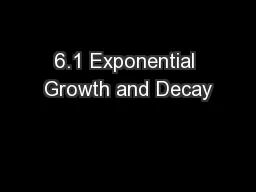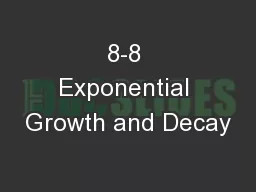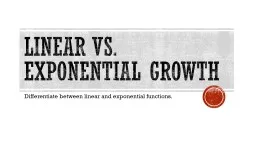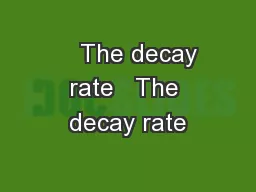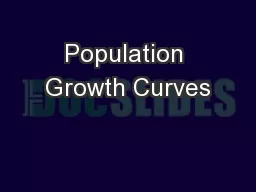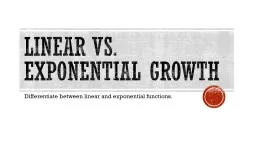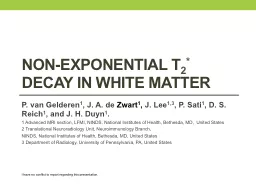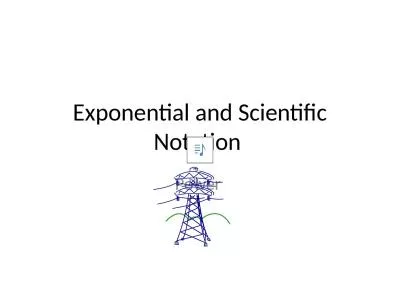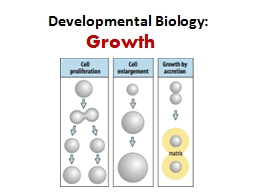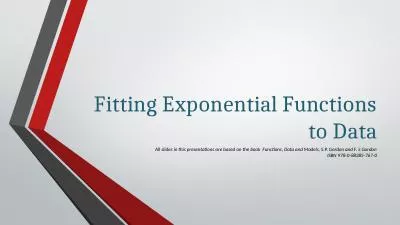PPT-6.1 Exponential Growth and Decay
Author : conchita-marotz | Published Date : 2018-02-06
Date WarmUp Rewrite each percent as a decimal 1 8 2 24 3 001 008 0024 00001 Evaluate each expression for x 3 4 2 x 5 503 x 6 2
Presentation Embed Code
Download Presentation
Download Presentation The PPT/PDF document "6.1 Exponential Growth and Decay" is the property of its rightful owner. Permission is granted to download and print the materials on this website for personal, non-commercial use only, and to display it on your personal computer provided you do not modify the materials and that you retain all copyright notices contained in the materials. By downloading content from our website, you accept the terms of this agreement.
6.1 Exponential Growth and Decay: Transcript
Date WarmUp Rewrite each percent as a decimal 1 8 2 24 3 001 008 0024 00001 Evaluate each expression for x 3 4 2 x 5 503 x 6 2. Sebastián Jordán, Valentina Carvajal, Rebeca Pérez-Anda, Juan Ignacio . Lalama. 04/15. Introduction. The Condor, is an important animal, . People have damaged most of the condor population.. T. h. Understanding the difference. Linear equations. These equations take the form:. . y. = . mx. + . b. . . m. is the slope of the line. . b. is the value of . y. when . x. = 0 . (the . y. - . Exponential Growth Functions. If a quantity increases by the same proportion . r. in each unit of time, then the quantity displays exponential growth and can be modeled by the . equation. Where. C = initial amount. Exponential Functions & Their Graphs. Logarithmic Functions & Their Graphs. Properties of Logarithms . Exponential and Logarithmic Equations. Exponential and Logarithmic Models. a. b.. RULE-. Exponential Growth. Modeling Exponential Growth . In 1998, a certain town had a population of about 13,000 people. Since 1998, the population has increased about 1.4% a year.. Write an equation to model the population increase.. Differentiate between linear and exponential functions.. 4. 3. 2. 1. 0. In addition to level 3, students make connections to other content areas and/or contextual situations outside of math.. . Students will construct, compare, and interpret linear and exponential function models and solve problems in context with each model.. . The decay rate. . Lorentz Invariant Phase Space. The decay rate. . The decay rate. . Decay amplitude. Describes the interactions during the decay.. The Feynman diagrams. The Feynman diagrams. Exponential Growth. (J-shaped curve). Logistic Growth. (S-shaped curve). Population ecology. Population ecology is the study of populations.. Population . = group of individuals of the same species occupying a common geographical area. Differentiate between linear and exponential functions.. 4. 3. 2. 1. 0. In addition to level 3, students make connections to other content areas and/or contextual situations outside of math.. . Students will construct, compare, and interpret linear and exponential function models and solve problems in context with each model.. 3.2 Exponential growth and decay: Constant percentage rates. 1. Learning Objectives:. Understand exponential functions and consequences of constant percentage change.. Calculate exponential growth, exponential decay, and the half-life.. Decay in . White Matter. P. van Gelderen. 1. , J. A. de . Zwart. 1. , . J. . Lee. 1,3. , . P. . Sati. 1. , . D. S. . Reich. 1. , . and J. H. . Duyn. 1. .. 1 Advanced . MRI section, LFMI, NINDS, National Institutes of Health, Bethesda, MD, . Power . Exponential Notation. A short hand of writing a number with out changing its Value. It only changes the way it looks.. * . . . . . . X10. #. x10. - #. Number gets larger . GROWTH. Growth. defined as the increase in size of an organism or of its parts due to the synthesis of . Protoplasm. (includes both cytoplasm and nucleus) or . Apoplasmatic. substances . (substance produced by cells and forms a part of the tissues . All slides in this presentations are based on the book Functions, Data and Models, S.P. Gordon and F. S Gordon. ISBN 978-0-88385-767-0. Fitting Data to An Exponential Function. Although Linear Regression is a powerful tool, not all relationships between two quantities are linear. (See scatterplots in figure 5.28).
Download Document
Here is the link to download the presentation.
"6.1 Exponential Growth and Decay"The content belongs to its owner. You may download and print it for personal use, without modification, and keep all copyright notices. By downloading, you agree to these terms.
Related Documents

